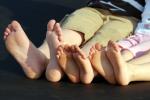Submitted by david on Wed, 09/04/2008 - 4:37pm
In What are the chances? we saw how the chance of a rare event occurring could be calculated for specific problems.
Submitted by david on Tue, 05/02/2008 - 10:51am
Suppose there are $aN$ lottery tickets sold, each with a chance $1/N$ of winning.
Submitted by david on Tue, 05/02/2008 - 10:35am
In Pick a Number - Level 1 we showed there is a 13% chance of a duplicate if 20 people choose a number between 1 and 100.
Give method for calculating that all different numbers chosen, for particular numbers, like 20 out of 100.
Submitted by david on Tue, 05/02/2008 - 10:29am
In Pick a Number - Level 2 we calculated the probability of a group of 20 people all picking different numbers between 1 and 100. Here we derive a general algebraic approximation.
Submitted by david on Tue, 05/02/2008 - 10:16am
A recent news story featured a family whose three children had all been born on January 29th. But is this so remarkable?
Submitted by david on Sat, 12/01/2008 - 9:42pm
Two women admitted to the maternity unit of the Royal Hampshire hospital on December 21st 2007 died of Streptococcus A infections within two days, one on December 23rd and one a day later. In a BBC News article the hospital said "their deaths appear to be coincidental".
So what is the chance of such an event happening by chance alone?

